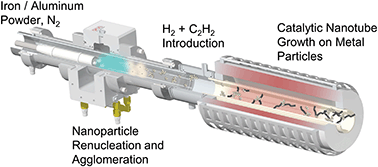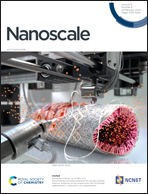Plasma production of nanomaterials for energy storage: continuous gas-phase synthesis of metal oxide CNT materials via a microwave plasma†
Abstract
In this work we show for the first time that a continuous plasma process can synthesize materials from bulk industrial powders to produce hierarchical structures for energy storage applications. The plasma production process’s unique advantages are that it is fast, inexpensive, and scalable due to its high energy density that enables low-cost precursors. The synthesized hierarchical material is comprised of iron oxide and aluminum oxide aggregate particles and carbon nanotubes grown in situ from the iron particles. New aerosol-based methods were used for the first time on a battery material to characterize aggregate and primary particle morphologies, while showing good agreement with observations from TEM measurements. As an anode for lithium ion batteries, a reversible capacity of 870 mA h g−1 based on metal oxide mass was observed and the material showed good recovery from high rate cycling. The high rate of material synthesis (∼10 s residence time) enables this plasma hierarchical material synthesis platform to be optimized as a means for energetic material production for the global energy storage material supply chain.



 Please wait while we load your content...
Please wait while we load your content...